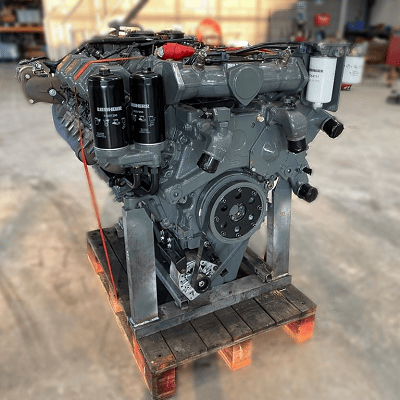The process of a dyno test on a Liebherr engine

When it comes to heavy machinery, reliability and power are paramount. Liebherr, a name synonymous with innovation and excellence in engineering, stands tall as a pioneer in the realm of heavy equipment and machinery. From towering cranes to robust excavators, Liebherr’s engineering prowess extends to the heart of these machines. We delve into the world of dyno testing a Liebherr engine, uncovering the meticulous process behind unleashing the raw power concealed within.
The foundation of excellence
Before we embark on the journey of dyno testing, it’s crucial to understand the foundation upon which Liebherr engines are built. With decades of engineering expertise and commitment to quality, Liebherr engines are crafted to withstand the most demanding environment and deliver unparalleled performance. Each component is meticulously designed and rigorously tested to ensure reliability, efficiency and longevity.
The process
1 Preparation: The engine undergoes meticulous preparation before being mounted onto the dynamo meter. This includes ensuring all connections are secure, fluids are filled to the appropriate levels, and sensors are properly calibrated.
2 Mounting: The engine is carefully mounted onto the dynamometer, a specialized device designed to simulate real-world operating conditions. Precision is paramount during this step to ensure accurate results.
3 Initial checks: Once mounted, a series of initial checks are conducted to verify proper alignment, connection integrity, and functionality of all engine systems.
4 Warm-up: The engine is started and allowed to warm up to operating temperature. This ensures consistent results and minimizes the risk of damage during testing.
5 Baseline testing: With the engine warmed up , baseline tests are conducted to establish initial performance metrics. This includes measuring power output, torque, fuel consumption, and emissions at various RPM levels.
6 Load testing: The engine is subjected to progressively increasing loads to simulate different operating conditions, such as idle, partial load and full load. This allows engineers to assess performance across the entire operating range and identify any potential issues or optimization.
7 Data analysis: Throughout the testing process, data is continuously collected and analyzed in real-time. Advanced instrumentation and software are used to monitor performance metrics and identify trends or anomalies.
8 Optimazation: Based on the data analysis, adjustments may be made to optimize engine performance. This could involve fine-tuning fuel injection timing, adjusting air-fuel ratios, or optimize turbocharger boost pressure.
9 Validation: Once testing is complete, the results are meticulously reviewed and validated against predetermined criteria and specifications. Any deviations or anomalies are thoroughly investigated to ensure accuracy and reliability.
10 Reporting: Finally, a comprehensive report is generated detailing the results of the dyno testing, including performance metrics, observations, and any recommendations for further optimization or refinement.
The outcome of dyno testing
Dyno testing a Liebherr engine is more than just a routine procedure – it’s a testament to the unwavering commitment to excellence that defines Liebherr’s engineering philosophy. By subjecting their engines to rigorous testing and analysis, Liebherr ensures that each engine delivers the uncompromising performance, reliability, and efficiency that customers expect.
In conclusion, dyno testing a Liebherr engine is not just about measuring power output. It’s about unlocking the true potential of these remarkable engines and ensuring they exceed expectations in the most challenging environments imaginable.
Tubing is mainly used to provide oil and gas flow passage during production of oil and gas wells. For flowing wells, due to the large inner diameter of the CASING, the casing is directly used for production. Due to the density difference, pressure drop and expansion, the liquid flows up rapidly, causing the liquid to slip, resulting in the ineffective utilization of the downhole elastic energy. Running tubing with smaller OD and ID during production can effectively solve the above problems by allowing fluid to flow in the tubing. Therefore, running tubing is required during production of flowing wells. The downhole operation and production of flowing well and non flowing well can be completed by using various tools for tubing running.
The basic requirements of the tubing used for workover are: to comply with the safety and economic principles, to meet the technical requirements adopted during well completion, and to meet the requirements for corrosion resistance and operation measures after the well is put into production.
According to the manufacturing process, oil pipes can be divided into seamless pipes and electric welded pipes. Seamless pipe is a kind of forged steel pipe without welding seam, which is made of hot working steel. After pressing, stretching, heat treatment and other processes, it reaches the standard size of oil pipe, forming a seamless oil pipe series. Electric welding pipe is a kind of pipe with a longitudinal weld formed by resistance welding or electric induction welding without filler metal. The welding edges are squeezed together by mechanical pressure, and the standard size oil pipes are reached through heat treatment and other processes, forming a series of electric welding pipes.
Tubing,Api 5Ct Tubing,Api Tubing,Seamless Api 5Ct
ESASTSUN OILFIELD EQUIPMENT MANUFACTURING (CAMBODIA) CO., LTD , https://www.eastsuncambodia.com